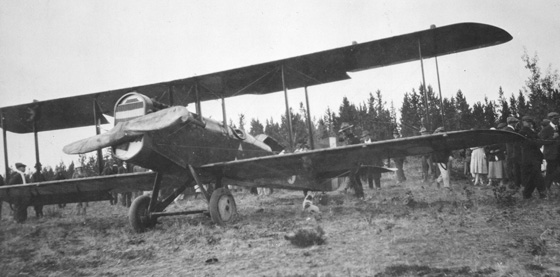
Photo by Whitehorse Star
Lieut. Crumrine's airplane from "The Alaska Flying Exp." His chronic tire problems were fixed by Whitehorse resident Bert Peterson of the White Pass. Harbottle Family Coll./Yukon Archives.

Photo by Whitehorse Star
Lieut. Crumrine's airplane from "The Alaska Flying Exp." His chronic tire problems were fixed by Whitehorse resident Bert Peterson of the White Pass. Harbottle Family Coll./Yukon Archives.
For a history of aviation in the Yukon Territory we have to go back to June, 1920, when Capt. H.T. Douglas of the U.S. Air Force and Capt. H.A. Leroyer of the Canadian Air Board arrived in Whitehorse to talk over a proposed international aeroplane flight from Mineola, N.Y. to Nome Alaska.
For a history of aviation in the Yukon Territory we have to go back to June, 1920, when Capt. H.T. Douglas of the U.S. Air Force and Capt. H.A. Leroyer of the Canadian Air Board arrived in Whitehorse to talk over a proposed international aeroplane flight from Mineola, N.Y. to Nome Alaska.
They both came with the authority of their respective governments to make all necessary arrangements for landing places, fuel, supplies, etc. In commenting on the proposed flight the Whitehorse STAR of that day described it as "an event that will go down in history as one of the most daring conceptions of the potentialities of aerial flight that has ever been conceived since the possibilities of a lighter-than-air craft as a means of transportation became, through the inventive genius of man, a certainty."
At the conference which took place the visitors stated they would require a field 600 yards long and 200 yards wide.
The day after their arrival they were escorted by the late Robert "Bob" Lowe and others to the site where the present airport is now located.
At the time it was covered with trees and brush which were quickly removed. The flight was being undertaken in order to ascertain the feasibility of establishing aerial routes in the far northland.
The planes were scheduled to leave Mineola, N.Y., on July 5, 1920, but they did not depart until ten days later.
The distance to be covered was estimated at approximately ten thousand miles and sixteen stops were to be made en route.
These included Erie, Pa.; Grand Rapids, Mich.; Winona, Minn,; Fargo, N.D.; Portal, N.D.; Saskatoon, Sask.; Edmonton, Alta.; Jasper House, Alta.; Prince George, B.C.; Hazelton, B.C.; Wrangell, Alaska; Whitehorse and Dawson, Y.T.; Fairbanks and Ruby, Alaska.
A telegram from Washington, D.C., addressed to the "Mayor" of Whitehorse, stated the planes would reach here on or about July 22.
A map of the Whitehorse airfield was prepared and sent to Wrangell for the use and benefit of the aviators, and a similar map of the Dawson airfield was sent here for the same purpose.
The airmen in this trans-continental flight met with many difficulties en route. However they reached Wrangell on Saturday, August 14, 1920, and on the following Monday the first plane arrived in Whitehorse.
Shortly afterwards two others appeared upon the horizon and were safely grounded on the local airfield. The fourth plane had met with difficulties on muddy ground at Wrangell and did not reach Whitehorse until Tuesday, August 17 - Discovery Day to us Yukoners.
Naturally the flyers received a royal welcome at the hands of the people of Whitehorse. Each plane used in the flight had a speed of 135 miles an hour and was overhauled every thirty hours.
The last plane to land in Whitehorse averaged one hundred miles an hour.
According to official calculations the planes had covered a distance of 2800 miles between New York and Whitehorse.
Just as mighty oaks from tiny acorns grow, so from the small airfield constructed for the above–mentioned first transcontinental flight north has developed one of the finest airports in the north today of which Whitehorse is justifiably proud.
In the past it played an important part in aviation throughout the north. In the future, because of its strategic position, it is destined to play an even greater part in global aviation.
H.E.M. 1947.
(Horace Moore, Star Editor)
In order to encourage thoughtful and responsible discussion, website comments will not be visible until a moderator approves them. Please add comments judiciously and refrain from maligning any individual or institution. Read about our user comment and privacy policies.
Your name and email address are required before your comment is posted. Otherwise, your comment will not be posted.
Comments (2)
Up 0 Down 0
Jacques LaPointe on Mar 14, 2021 at 11:49 am
Did the Cyr brothers in Whitehorse, formerly natives of Saint Leonard, New Brunswick, own the land where the Whitehorse airport was eventually built.....
Any historical documents on this subject....Thanks
Up 0 Down 0
Rick on Apr 28, 2020 at 8:13 am
A picture of Jimmie Mattern's The Texan is posted on a facebook page about the history of my hometown, Gig Harbor, WA (perhaps on his way to Alaska to search for Levanesky). The person who posted the picture says it was taken by her grandfather, a lifelong friend of H.T. Douglass, two "esses", who was described as a bush pilot in Alaska; must be the same person?